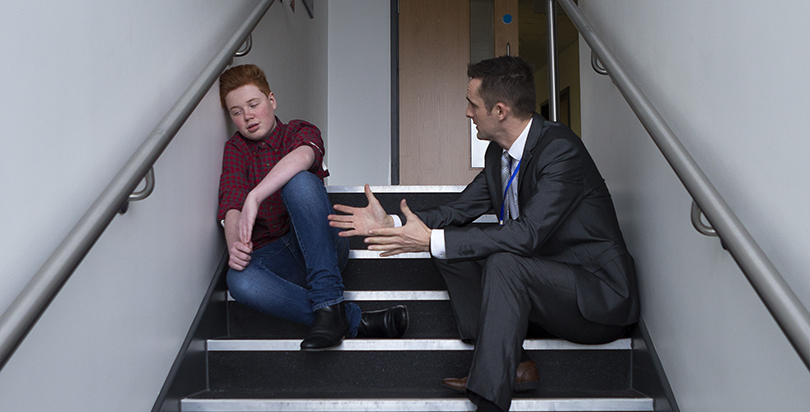Cami Anderson: The Left-Right School Discipline Debate Misses the Point. We Need a Third Way

Imagine a small math classroom filled with exuberant 12-year-olds. They are loud and engaged. One group is working on algebra and comparing notes to solve a problem. Another group is using a self-paced computer program to practice foundational math skills that an assessment indicated to their teacher they needed. A third is being guided by the teacher through a problem requiring complex equations.
Occasionally, one of the groups erupts in laughter; you might hear someone blurt out, “I am never going to get this” — only to go right back to work. A chime signals the time to change activities; student captains keep the transition smooth. There’s a little horseplay and poking, but within minutes, students are at their stations enthusiastically tackling a new task.
The scene could be an elite private school, but it’s actually a crowded sixth-grade classroom in one of the country’s poorest ZIP codes. When you visit, you don’t wonder if the teacher can “control” the class or question if poor kids can succeed at high academic levels.
Instead, you meet a teacher who visits students’ homes and gets to know what makes each child tick. She can vividly describe their dreams, what motivates and triggers each one, how she helps them identify those patterns for themselves. She can talk about the systems and rituals she constructs with students and how she puts them in charge of their learning and behavior.
She’d invite you to observe class meetings and restorative circles, where students repair relationships and personal damage when the students challenge authority and show disrespect, as they inevitably will, even in this carefully built community. For her and the mission-driven school team she is part of, student discipline means coaching children to develop the habit of persisting to master a skill, however hard.
Others in her school, from the principal to teachers and school safety agents, will tell you discipline doesn’t mean punishing young people who fail to comply.
Much has been written lately about whether schools should be called to task for how they discipline kids. Civil rights groups say punitive discipline is racially biased and disproportionately pushes kids of color into an even more racist judicial system that severely limits their life options. They’re right: 10 percent of all high schoolers are suspended; among male African Americans, the figure is about one-third.
Nearly half of school-based arrests are of African-American students (though they are nowhere near 50 percent of students). Being suspended makes you three times as likely to drop out and three times as likely to become incarcerated.
Some conservative publications and think tanks, such as the Manhattan Institute, which recently published a study about school discipline, argue that limiting punitive discipline leads to lower teacher morale. To some extent, they are right. Teacher surveys in New York show that some teachers and students report that their schools feel less safe since central administrators have made it much harder for teachers to remove kids from their class.
But the debate about discipline among adults, as it’s being argued, mistakes the response for the cure. Simply decrying the injustice of disproportionate suspensions doesn’t help kids, but suggesting schools will descend into chaos if we stop suspending “bad kids” is worse. We need a third way that integrates a school’s approach to discipline with high-quality, culturally competent school cultures, teaching and learning practices, and student supports, and that builds the capacity of schools to make good on this approach.
Here’s an analogy. For much of my childhood, I was a competitive swimmer. I didn’t win a lot, though, because my flip-turn was too slow. My coach saw that I took an extra stroke, and though we tried to fix it, my times stagnated. He blamed himself: He’d been too technical, faulted me publicly, didn’t study enough tape. Or maybe he needed to motivate me to work harder.
In the end, it was all of these. We kept at it and I became much faster. I never heard him say, “Too bad Cami didn’t get the flip-turn gene” or “I’ll bench her if she doesn’t improve that flip-turn.”
My swim coach and the math teacher I observed have a lot in common. They believe habits can be changed and that it’s their job to figure out how for children who can’t do it alone. They constantly think about adaptations that may help students achieve peak performance. They both have high expectations, but they’re able to seed them by putting kids at the helm.
We would never say of a child that “he just can’t learn how to read”; similarly we shouldn’t wonder whether young people can learn self-control, how to de-escalate anger, resolve conflict, and focus. We need instead to think of how to effectuate that growth, as if we were coaches of the academic, social, and emotional skills of our kids, even when they challenge us.
Having taught young people who were suspended, run suspension centers, overseen the schools on Rikers Island, and been in many school lockdowns, I know this is a difficult shift. It takes more than a pious call to “decrease suspensions” or a reliance on individual acts by heroic teachers.
Improving school culture is much more demanding as well as inseparable from the rest of school life. We need to systematically rethink everything we do — from how teachers are trained and supported to how we report and learn from classroom and school-based incidents. We need to take a hard look at whether we are building school cultures that empower all students to perform hard work that is meaningful to them. We need systems that ensure that students who challenge authority or hurt others are coached, not pathologized.
Most of all, regardless of how difficult it is to reach every student, including those who make bad choices, we have to stop weighing whether or not the status quo is acceptable. When the United States of America has more African Americans incarcerated than were enslaved in 1850, everyone who contributes to the school-to-prison pipeline is either part of the problem or part of the solution.
Get stories like these delivered straight to your inbox. Sign up for The 74 Newsletter

;)
